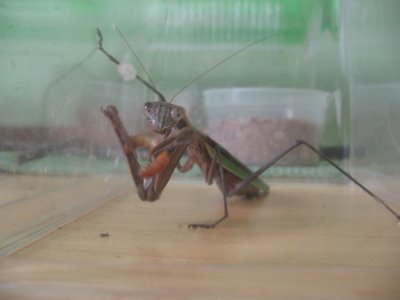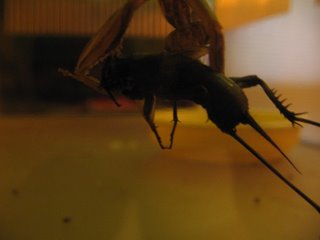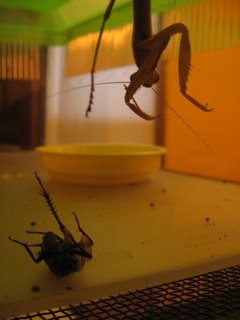Tuesday, November 3, 2009
Darwinian Art
(Hat tip: Katie B.)
Saturday, October 24, 2009
Are Rattlesnakes Only Found in North America?
There are 27 species of rattlesnake, split into two genera. (The genus Sistrurus consists of 9 speices found exclusively in Canada, the United States, and Mexico. The other 18 species are of the genus Crotalus, found from southern Canada to northern Argentina.)


...
If you have a burning question about nature or natural history, I might enjoy finding the answer for you. Feel free to email it to me.
Monday, October 19, 2009
Sunday, October 18, 2009
The Latest from Sir David Attenborough
You've got to see his (and the British taxpayers') latest. It's called Life, and as this article says, "Think of it as 'Planet Earth: Part II'". If you've seen Planet Earth, and you know how amazing that footage is, then you know what they're talking about.
It's highly recommended that you watch all three video clips linked to here at Gizmodo (an online technology magazine).
(Hat tip: Matt B.)

Wednesday, October 14, 2009
Can Spider Silk Be Used to Make Cloth?

Gold silk from 1,000 spiders in Madagascar.

Read the full story here:
http://www.wired.com/wiredscience/2009/09/spider-silk/
(Hat tip: Matt B.)
Friday, September 18, 2009
A "Mantidote" for the Wintertime Blues?
(This is a post from a previous incarnation of this blog, when I lived in the Midwest. As we approach autumn again, and since it's currently raining praying mantises in southern California, I thought it could be worth revisiting.)
Despite the dark pleasures of autumn, which I alluded to in a previous post, we know that it all comes to an end about this time November. Strong winds will have stripped that very last vestige of life—the leaves—from the surrounding landscape, and one is left coping with winter’s stark dormancy. This is certainly a cause for depression among creature-lovers.
But mope not, because if you act now, you can preserve one of summer’s treasures to last you well into the winter season. And it’s as simple as this: Go outside right now and catch yourself a praying mantis.
The fact is, as one of the largest insects in North America, praying mantises make a particularly symbolic piece of warmer weather memorabilia. They’re also a great wild animal to collect at this time of year. And here, I think, are the top three reasons why:

(Jerry the Praying Mantis, munching on a beetle larva.)
Number 1: They seem to be readily abundant. That’s undoubtedly something to do with their life cycle: females lay up to 300 eggs, with some hatching in small intervals. And that brings us to...
Number 2: They’re just going to die anyway. That’s because they hatch out in the spring, spend all summer preying (and “praying”), mate & lay their eggs in the fall, and then promptly die from old age or frost, "whichever comes first”.
And finally, Number 3: They are simply amazing to behold. I know, because I kept one last year—his name was Jerry. Fascinatingly, mantises are one of the few insects that can rotate their heads. They also appear to have excellent vision (their eyes are a curiosity unto themselves), and a mantis’ motions and behaviors seem almost as intelligent as those of a small vertebrate.
Of the four or five people who read this blog, I know I’ve got at least one predator-lover out there (you know who you are), so I’ll now say something a bit gory regarding how a praying mantis captures and consumes its prey. (The faint of heart should read no further.) Jerry would hang upside down and ‘swoop’ his spiny forelegs down to capture an unsuspecting cricket. Grasping it tightly to the point that it could not move, he would then chew a small, rectangular incision into the top of the cricket’s thorax (just below the vestigial wings), and proceed to munch the life right out of it. It’s awesomely gruesome, and guaranteed to send shivers right down your spine! (In fact I just got shivers merely thinking about it again.) Happily, no mantis poses any serious threat to human beings, though the mandibles can deliver a painful pinch, so just remember not to be foolish (like I was) and pick them up.
By the way, once your praying mantis finally kicks the bucket, you can easily preserve him for years (and quite nicely) with ethyl alcohol or formaldehyde. Barring that, rubbing alcohol will keep him looking like a sharp souvenir for several months.
Happy bugging, everybody!
The true story of Jerry and the cricket:


PS: To prove to yourself what awesome predators praying mantises are, be sure to check out this website, Praying Mantis Makes Meal of a Hummingbird (it's for real!).
Update 2: From Wikipedia, more excellent photos of mantids here, including a link to a YouTube! video of a mantis capturing a cricket.
Wednesday, September 16, 2009
Snake with Foot Found in China

Thursday, August 27, 2009
Why 'evolution'?
But is this term really the best choice?
Etymologically, the term is derived from the Latin evolvere, meaning unrolling, or unfolding. Merriam-Webster’s defines evolution variously as “a process of change in a certain direction”, “the process of working out or developing”, etc.
I think it’s safe to assume that to most people, the term connotes change. I know that’s what I used to think of when I heard the word “evolution”: a living species changing over time to become something new.
And here’s this, from a prominent book on science education standards (Science for All Americans), regarding Darwin’s intellectual contribution:
“…Prior to Darwin’s time, the prevailing view was that species did not change, that since the beginning of time all known species had been exactly as they were in the present….
One line of thought was that organisms would change slightly during their lifetimes in response to environmental conditions, and that those changes could be passed on to their offspring…
Darwin offered a very different mechanism of evolution. He theorized that inherited variations among individuals within a species made some of them more likely than others to survive and have offspring, and that their offspring would inherit those advantages. Over successive generations, advantageous characteristics would crowd out others, under some circumstances, and thereby give rise to new species.”
(Italics mine.)
So again we see: the focus is on change, undoubtedly a result of our use of the term “evolution” to encapsulate Darwin’s main idea.
I propose to challenge this. Isn’t the existence of species-change less fundamental than common descent (i.e. the notion that all organisms are literally blood-relatives of each other, however distant)?
Wouldn’t common descent better capture the profoundest insight of Darwin’s intellectual contribution?
Wednesday, June 17, 2009
Mountain Lion Princes of Malibu

(Image source: US Dept. of Agriculture)
Via the Mountain Lion Foundation's weekly newsletter Cougar Clippings, I read this fascinating blog post (LAist.com) about the mountain lions being tracked in the Santa Monica Mountains. (The Santa Monicas are the coastal mountain range along the Los Angeles Metro Area's northwestern edge).
Here's an excerpt:
"The technology used to track the lions is improving fast. Today, the collars send GPS signals to a satellite that are downloaded at park headquarters in Thousand Oaks. They get a handful of locations every 24 hours, one during the day and one every two hours at night, when they are most active.... The tracking of each cat tells a different story, although their lives are all intertwined. Here's a break down of each..."
The post then goes on to describe the almost soap opera-like interactions (!) of all twelve plus mountain lions being tracked. Read it in its entirety here.
Sunday, May 31, 2009
My Hollywood Debut

To see the original photograph and entry, visit my Orange County Nature post, "Pacific Tree Frog".
I'm hoping that this won't significantly change my lifestyle. If the paparazzi recognizes my palm while I'm out in public places, they'll probably start to follow me around and figure out where I live.
Sunday, May 24, 2009
The Jungles of Illinois
Amazingly, remnants of a 300 million year old jungle were recently found deep beneath the flat, blacksoil Illinois landscape not far from where I used to live (Champaign), in nextdoor Vermilion County.
Did you get that?
Remnants of a 300 million year old jungle were found by coal miners working no more than a 45 minute drive away from the University of Illinois.

"It covers about 15 square miles, all more than 200 feet below ground, and probably is the largest intact rain forest from that period ever studied, according to Scott Elrick of the Illinois State Geological Survey."
"'It's that scale that makes what lies just above the Riola and Vermilion Grove mines significant,' he said.""'We never encountered one whole forest preserved in one shot like this,' Elrick said Monday. 'The fossils just didn't stop."
"It's common to find small pockets of fossilized plants just above coal mines, he said. But in this case, experts believe, a fault that runs through the area unleashed a major earthquake that quickly sank the forest beneath a deep layer of mud, preserving it."
Read the full article here, via the Discovery Channel.